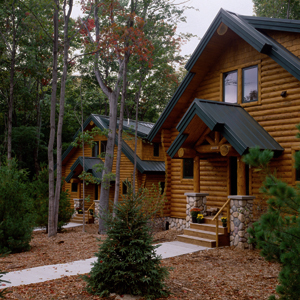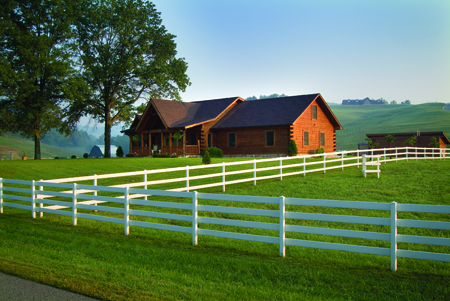For Fred and Natasha Ruckel of New York City, the dream of owning a log cabin began one day when they were driving down the interstate. “Natasha and I saw a log model home off the highway,” Fred recalls. “She said that she had always wanted to have one, and so did I.” With floorplans completed and log package purchased, they bought land that offered great scenery and a perfect spot to site the home.
But, this is where the dream ended and the reality took over. “We had cleared the land, but complications with the neighbors began.” The result: Fred and Natasha had to sell the land and look for another place to build. Ultimately, this experience of buying land made them smarter and happier consumers the next time. With the right information in hand before you buy, you can feel confident in purchasing land for your log home the first time.
Determine your budget. This figure should comprise the entire building budget including buying the land, purchasing the log package, and having your home built. Once you have determined how much of the budget you can spend on land, you’ll have a better idea of the size lot you can afford.
Figure out where you want to build your log home. Is it going to be your primary home, or will it be used as a weekend or vacation getaway? If it’s your primary home, look at the distance to schools, shopping, emergency services, and hospitals. For a vacation home, how far do you want to travel to get there? Who will maintain the home when you are not there? Can it be used as a rental property? Answers to these questions will help you figure out where to look for land.

Town & Country Cedar Homes/photo by Roger Wade
Know what you are buying and what surrounds you. Check with the local authorities to determine zoning ordinances. This will tell you if there are any restrictions on the type of home you can build and any zoning restrictions. Get to know your neighbors and find out about their experiences living in that area. Have they ever had problems with flooding or downed power lines? Also, ask about future zoning to see if there are any plans to build on the surrounding land. You wouldn’t want to get stuck next to a future shopping center.
Access to the site is important. Determine if there is direct access to main roads from the land. If not, you will have to obtain an easement if it crosses another person’s property. Also, find a builder who is willing to travel to remote areas and ensure that building materials can be delivered. If there is no road, you will have to pay for one to be built before the trucks can roll in. “Getting the logs to the lot is a big consideration,” says Ronnie Wilson, general manager of Jim Barna Log & Timber Homes in Oneida, Tennessee. “The driveway has to be wide enough and cleared out to accommodate a tractor trailer.”
How will you access utilities? Will you be able to tap into the municipal supplies for water or sewage? Or will you have to dig a well and septic system? If so, make sure that the land is suitable for these before you buy it. Think about the cost and feasibility of bringing in electricity and phone service if they aren’t available.
Don’t forget about the design of your home. The floorplan and the land have to match. “For instance, if you really want a walkout basement, then you need to find a lot with a slope,” Ronnie says. Talk to your log home company representative or general contractor and ask for their suggestions on the type of land that you should be looking for to best fit your home.
Consider buying land within a planned development. Review any covenants carefully to verify that log homes can be built within the community. If so, much of the legwork is already done. Within a development, you have a choice of plots that have been approved for home building. Many communities will include power to the doorstep and paved roads and driveways. With these already done for you, choosing the perfect site depends on other personal factors. “I would have to say that most people are driven by budget when it comes to picking a lot,” says Carol Dilley of The Settlement of Thomas Divide in Bryson City, North Carolina. “Think in terms of what you want to build and where you want to put it. Then find the land to fit your needs.”
Carol says that the price of land is driven more by the views and ease of building rather than parcel size. “Typically, a more beautiful view is more expensive than the side of a mountain,” she says. “Plus, the more level the land, the more expensive it is.”
In addition to the land, developments offer everyday benefits, like golf courses, hiking trails and skiing, equestrian facilities and lakes either within the community or nearby. “Be aware of your lifestyle and what you want to achieve,” Carol advises, “when selecting a log home-friendly community.” But do be aware of any covenants and guidelines that a development may have, such as architectural design approval.
Do your research. Resources to find land are right at your fingertips. Online searches are good for local and long-distance searches. Fred and Natasha suggest using Google maps to check out the land before you travel to the site. Check your local newspaper’s classified section to see what’s available. Enlist the help of a real estate agent who specializes in land.
For each log home there is the perfect piece of land to put it on. It may be a secluded spot on the side of a mountain on several acres, or a tract overlooking a lake in a log home community. Now, you just have to figure out what constitutes your ideal home site.


.jpg)